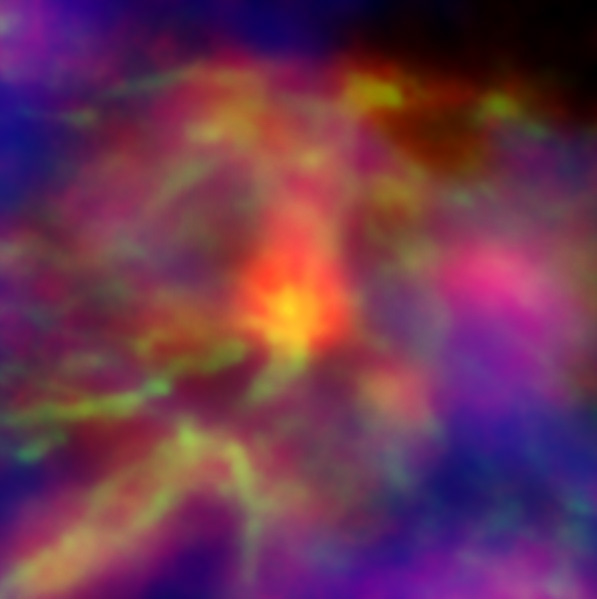| Basic Information | |
| What is this? | Anomalous emission in Rho Ophiuchus |
| Where is it in the sky? | In the constellations of Ophiuchus the Serpent Bearer |
| How big is it? | The image is 5 degrees across |
| How far away is it? | Most of the material is hundreds or thousands of light years away |
| What do the colours represent? | Blue represents electrons moving through the Galaxy, green the dust warmed by stars, and red the snomalous emission observed by Planck |
Downloads
As well as stars, our Galaxy contains a variety of other types of material. At microwave wavelengths, Planck see electons moving through the Galaxy, and dust being warmed by starlight from stars forming within. These components of the interstellar medium have studied at length over several decades. The electrons are known to emit primarily at radio waves (low frequencies), while the dust grains primarily in the far-infrared (high frequencies). In the 1990s, emission was observed which couldn’t be explained by either, and became known as “Anomalous Microwave Emission”.
Several theories of the origin of this emission have been proposed, and now the wavelength coverage of Planck’s Low Frequency Instrument is ideal for observing and characterising it. An advantage that Planck has is that the combination of the two instruments give a much broader wavelength coverage, which allows the separation of this anomalous emission from the better understood components.
“We are now becoming rather confident that the emission is due to nano-scale spinning grains of dust, which rotate up to ten thousand million times per second,” says Clive Dickinson from the University of Manchester, who led an analysis of the AME using Planck’s maps. “These are the smallest dust grains known, comprising only 10 to 50 atoms; spun up by collisions with atoms or photons, they emit radiation at frequencies between 10 and 60 GHz,” he explains.
The Rho Ophiuchus region was one of two regions within our Galaxy studied in detail. Thanks to Planck’s high sensitivity and to its unprecedented spectral coverage, it has been possible to characterise the anomalous emission arising from these two objects in such great detail that many of the alternative theories could be discarded, and to show that at least a significant contribution to the AME, if not the only one, is due to nano-scale spinning dust grains.
This is one of a number of early Planck results based on papers published in early 2011.
